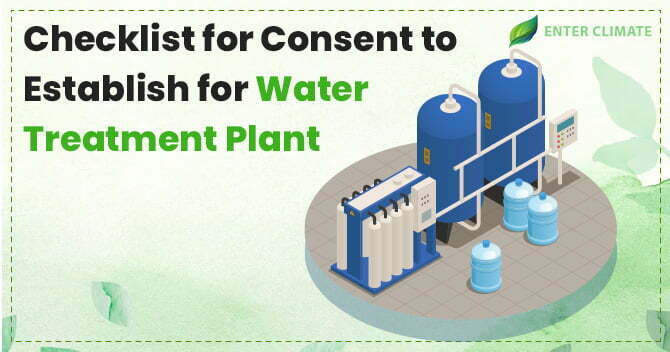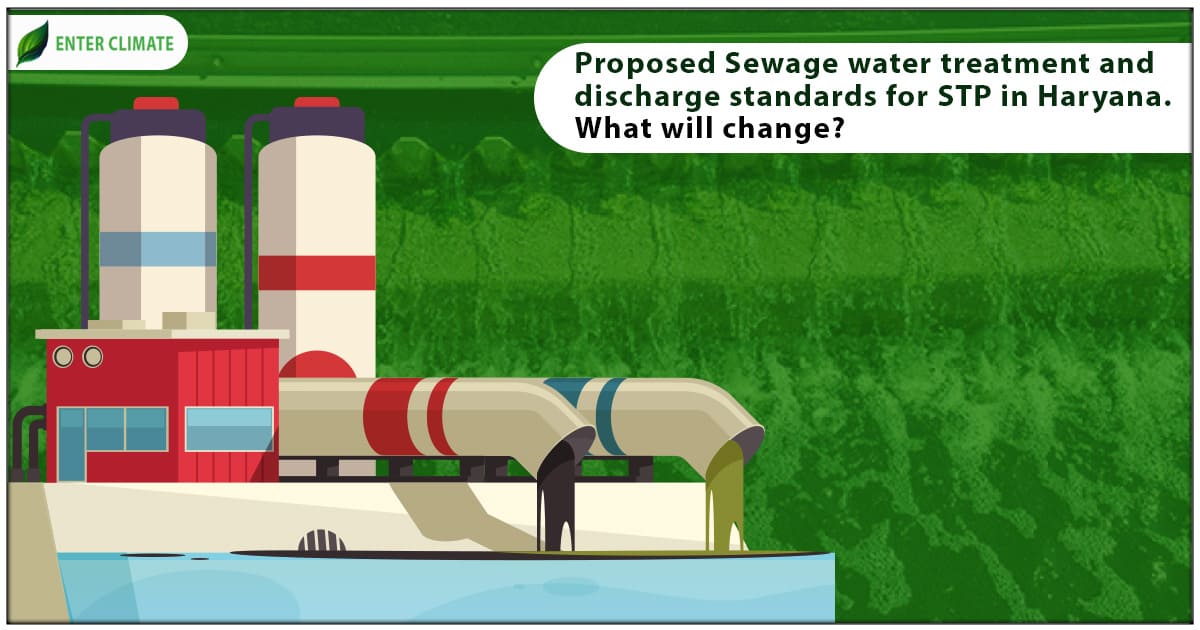Checklist for Consent to Establish for Water Treatment Plant
 03 Aug, 2022
03 Aug, 2022 
Wastewater from industries and households has to be treated before it can be discharged into the environment. A water treatment plant (WTP)generally refers to units that treat ground or stored water to specific standards where it becomes fit for human consumption. These facilities are generally operated by local municipal corporations tasked with supplying potable water to households. However, this article will focus on the plants that treat industrial effluents (ETP) and domestic sewage waste(STP). The standard of treatment for this wastewater category varies according to the purpose it will be deployed to. Generally, wastewater from industries and sewage is treated and discharged into water streams or reused for industries, irrigation purposes etc. The wastewater from domestic sewage discharge is also treated through water treatment plants. While physical and chemical treatment of water is the primary purpose at these facilities, their scope is not limited. An Effluent Treatment Plant is employed for cleaning industries discharges, whereas a Sewage Treatment Plant cleanses household water. In this article, we will focus on the checklist for Consent to Establish for Water Treatment Plant, which will cover all necessary aspects to be considered if one wants to install such a facility. The article will include details like the category of the water treatment plant, data and reports needed to prepare layout plans, flowchart and pollution control measures, and most importantly, the procedure for obtaining CTE.
Categorisation of Water Treatment plants
WTP can be of the following types
- Sewage Treatment Plants (STPs)
- Effluent Treatment Plants (ETPs)
- Activated sludge plants
- Common and combined effluent treatment plants (CETP)
Data checklist to develop WTPorganisational plan
- General Description of Local Conditions
- Surface Data like Survey control, Topographic Map,
- foundation data like Geological Data, Engineering Data
- Corrosion Survey
- Construction Consideration like Water needed for the Construction phase as well as the operational phase
- Hydrologic Data
- Cost Data
Checklist for Consent to Establish
To bring transparency in the application process for Consent to Establish (CTE) and Consent to Operate (CTO), an Online Consent Management and Monitoring System (OCMMS)[2] has been introduced. A new water treatment plant has to file applications for CTE from the concerned State Pollution Control Board along with the required enclosures to their respective SPCB. It is the most crucial section of the Checklist for Consent to Establish.
Checklist for Consent to Establish: Types of CTE Application
A checklist for consent to establish should include zeroing in which category of Consent the application has to be filed. Consent to Establish is provided for the following situations.
- CTE for Discharge: Under the Water and Air Act[1], any new WTP unit must apply for fresh consent through the OCMMS portal of SPCB of their respective state.
- CTE for extension: New industries, which have previously obtained CTE, must file a requisition letter for CTE-Extension from the Board if they need an extension of CTE.
- CTE-Revised: After obtaining CTE, if the WTP want to revise the consented products, Effluent and Air emission data before obtaining CTO, they have to file applications for CTE-Revised from the Board along with the revised one set of required enclosures.
- CTE-Expansion-Water: Existing WTP will have to file applications for CTE-Expansion from the Board for Expansion &modernisation activities incorporating expansion activities along with a comparison statement and one set of required enclosures.
Checklist for Consent to Establish: Documents Required
An essential part of the checklist for Consent to Establish is proper documentation. The following documents will be required to obtain CTE in most of the abovementioned situations.
- A covering requisition document stating the industry’s status and activities clearly.
- Copy of Sale /Lease Deed or any other documents as proof to ensure possession of the site
- Copy of MOA in case of Public/Private sectors or registered partnership deed in case of Partnership Company.
- Layout plan showing the location of various equipment
- Topo sketch showing the distance of the plant from water bodies, roads, existing/proposed residential areas, agricultural lands, important religious locations, educational institutions, ancient monuments, archaeological places and other sensitive areas for 1 km radius from the units
- Detailed manufacturing process
- Details of Water Balance and wastewater balance
- Land use classification certificate obtained from DTCP/LPA/CMDA
- Auditor’s Certificate with break-up details for the proposed Gross fixed Assets duly certified by a Chartered Accountant
- Groundwater clearance obtained from the competent Authority
Checklist for Consent to Establish – Proposal
In the case of a Sewage Treatment Plant, the proposal must contain the following
- details related to design of sewage treatment methodology,
- mode of disposal
- design criteria for various units
- detailed drawing of STP and its layout
- a diagrammatic representation of hydraulic profile and
- mode of disposal of treated waste and its adequacy (If applicable)
In the case of an Effluent Treatment Plant (ETP), the proposal must contain the following
- details like breakup quantity of water requirement, sources
- breakup quantity of trade effluent
- sources of trade effluent
- characteristics of wastewater
- treatment methodology
- mode of disposal
- design criteria for various units
- detailed drawing of ETP and its layout
- a diagrammatic representation of the hydraulic profile and
- mode of disposal of treated effluent waste and its adequacy (If applicable).
Post Compliance for Water Treatment Plant
- The maximum permissible Fixed Dissolved Solids (FDS) contribution by constituent units of a Common Effluent Treatment Plant (CETP) is 1000 milligram/litre. In cases where FDS concentration in raw water used by the constituent units is already high (more than 1100 mg/l), the maximum permissible value for FDS in treated effluent shall be accordingly modified by the State Board.
- In case the treated effluent is used on land for irrigation, the impact on soil and groundwater quality will be monitored twice a year (pre- and post-monsoon) by CETP management. For combined discharge of treated effluent and sewage on land for irrigation, the mixing ratio with sewage is prescribed by State Board.
- Discharge of treated effluent into the sea must be through the proper marine outfall. The existing shore discharges should be converted to marine outfalls. In cases where the marine outfall provides a minimum initial dilution of 150 times at the point of discharge and a minimum dilution of 1500 times at a point 100 m away from the discharge point, then the State Board may relax the Chemical Oxygen Demand (COD) limit.
Conclusion
A wastewater treatment plant aims to achieve water quality standards in line with water safety regulations of the country. It reduces the consumption of water in industries and environmental pollution. A giant volume of on-site industrial wastewater may be reusable by treating it in the Water Treatment Plant. Conducting a cost-benefit analysis for Water Treatment Plant after going through the above checklist for Consent to Establish will provide exceptionally high revenue in due time in the form of internal and external income. Internal income from WTP can include revenues obtained from the sale of the by-products recovered during the wastewater treatment process. Also, reclaimed water from WTPis used in agriculture, and the nitrogen and phosphorus content in the water saves fertiliser costs in agricultural practices. External revenue can include profits from energy generation, water supply and additional incentives provided by the state government.
Categories
Latest Post
Air pollution Dispersion Modeling
Natural Disaster Risk Assessment
Endangered Species Protection
Aquifer Recharge Project
Sustainable Sanitation Solutions














